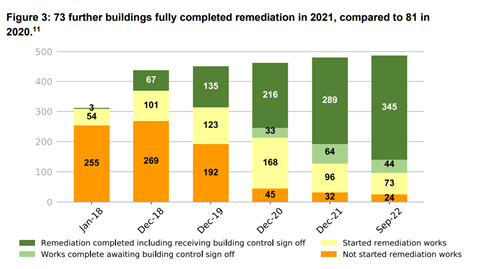Buildings still in need of remediation concentrated in London and Manchester
One in 10 residential high rises identified in the aftermath of the Grenfell Tower tragedy are still clad with dangerous aluminium composite material (ACM) panels.
In total, 48 buildings, largely concentrated around Manchester and Greater London, have yet to be fully remediated and are unlikely to meet new Building Regulations, according to the latest statistics released by the Department for Levelling Up, Housing and Communities.

Half of these (24) are yet to even begin remediation and within this group, nine have not got beyond announcing their intention to remediate. There remains one building where remediation plans are still unclear.
Seven out of 10 (345) of the at-risk high-rises have been fully remediated and received building control sign-off, while a further 93 have had ACM cladding fully removed or are complete and awaiting sign-off.
While completions rose month-on-month, the number of buildings which have not started remediation works – almost entirely private sector residential – has remained the same for three successive months.
The buildings which still need to be fully remediated are largely concentrated around urbanized areas in England, with Salford, Brent and Tower Hamlets each having between 10 and 20 buildings in their local authority areas alone.
The department estimates that by the end of the year, 96% of the unsafe buildings will have started or completed remediation.
Of the 20 remaining buildings, two are vacant, and enforcement action is being taken against a further 11.
The figures came as Bellway revealed a sharp drop in pre-tax profit owing to a £346m provision for fire safety repairs.
The Newcastle-based, listed housebuilder said it now expected volume for the current financial year to be “similar” to the 2022 level.











No comments yet